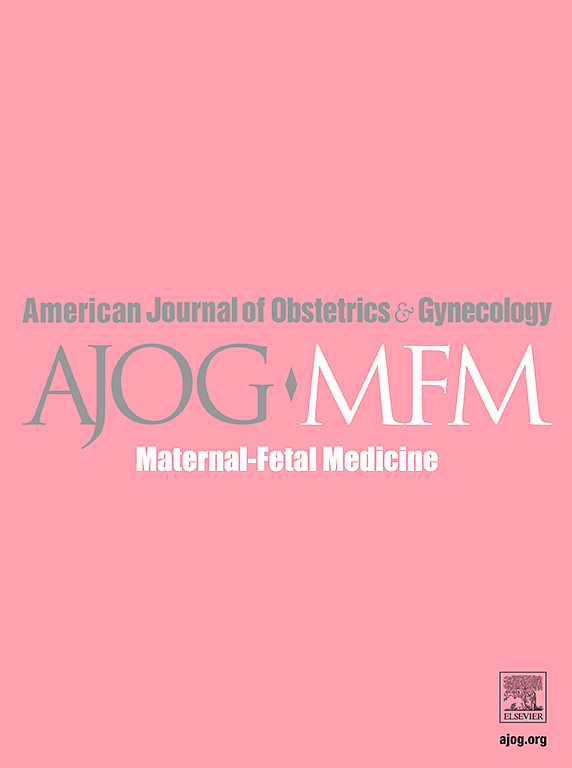一项随机对照试验:乳房刺激与低剂量催产素对有剖宫产史的妇女助产。
IF 3.8
2区 医学
Q1 OBSTETRICS & GYNECOLOGY
American Journal of Obstetrics & Gynecology Mfm
Pub Date : 2025-03-05
DOI:10.1016/j.ajogmf.2025.101658
引用次数: 0
摘要
背景:催产素和乳房刺激是既往剖宫产(CD)妇女增产的方法。与自然分娩相比,有乳糜泻病史的妇女经助产术会增加子宫破裂的风险。对于有乳糜泻病史的妇女,助产术的最佳方法尚未确定。目的:在一组既往患有乳糜泻的患者中,我们旨在比较产妇和新生儿根据助产方法的结局;乳房刺激或静脉注射催产素。研究设计:本随机对照试验(RCT)在一所高等学校附属医院进行。参与者先前有一次CD和宫颈扩张2-6厘米,子宫收缩不足,定义为每10分钟少于3次,并且是助产的候选人。她们被随机分为两组,一组是使用吸乳器刺激乳房,另一组是静脉注射低剂量的催产素,剂量从0.5-2毫单位/分钟开始,每15-40分钟增加1-2毫单位/分钟。插入宫内压力导管。两种隆胸治疗最多持续12小时。如果12小时内未发生主动分娩,则认为干预失败。进行意向治疗分析。共同的主要结局是从隆胸到分娩的时间,以及用蒙得维的亚单位测量的子宫收缩强度。次要结局包括干预失败、羊水粪染、剖宫产后阴道分娩、子宫破裂、感染结局、产后出血和产妇住院时间。新生儿结局包括:5分钟时Apgar评分、脐带ph值。结果:乳房刺激组33例,静脉注射催产素组34例。参与者的人口统计学和产科特征相似。乳房刺激组从增强到分娩的中位时间比催产素组更长:10.9小时(总范围1.5-63.2)vs. 5.1小时(0.8-30)。结论:我们发现,在既往有CD的患者中,乳房刺激与静脉注射催产素相比是有效的,阴道分娩率相似,24小时内分娩,以及更少的心动过速。需要更大的随机对照试验来确认乳房刺激隆胸的安全性。本文章由计算机程序翻译,如有差异,请以英文原文为准。
Breast stimulation vs low dose oxytocin for labor augmentation in women with a previous cesarean delivery, a randomized controlled trial
Background
Oxytocin and breast stimulation are methods used for labor augmentation in women with a previous cesarean delivery (CD). Compared to spontaneous labor, labor augmentation has been shown to increase the risk of uterine rupture in women with a previous CD. The optimal method of labor augmentation for women with a prior CD has not been established.
Objective
In a cohort of patients with one previous CD, we aimed to compare maternal and neonatal outcomes according to the method of labor augmentation; breast stimulation or intravenous oxytocin.
Study Design
This randomized controlled trial (RCT) was conducted at a single, tertiary, university-affiliated hospital. The participants had one previous CD and a cervical dilatation of 2 to 6 cm, had inadequate uterine contractions, defined as less than 3 per 10 minutes, and were candidates for labor augmentation. They were randomized for augmentation by breast stimulation using a breast pump, or by intravenous low-dose oxytocin starting at 0.5 to 2 milliunits/min and increasing incrementally by 1 to 2 milliunits/min every 15 to 40 minutes. An intrauterine pressure catheter was inserted. Both augmentation treatments were continued for a maximum of 12 hours. If active labor did not occur within 12 hours, the intervention was deemed a failure. An intention-to-treat analysis was performed. The co-primary outcomes were the time from augmentation to delivery, and uterine contraction intensity as measured by Montevideo units (MVU). Secondary outcomes included intervention failure, meconium-stained amniotic fluid, vaginal delivery after cesarean section, uterine rupture, infectious outcomes, postpartum hemorrhage, and maternal hospitalization length. The neonatal outcomes included: Apgar score at 5 minutes, umbilical cord pH<7.1, neonatal intensive care unit admission, asphyxia, and perinatal death.
Results
The breast stimulation and the intravenous oxytocin groups included 33 and 34 patients, respectively. The participants’ demographic and obstetric characteristics were similar. The median time from augmentation to delivery was longer in the breast stimulation than the oxytocin group: 10.9 hours (total range 1.5–63.2) vs 5.1 hours (0.8–30), P<.001. The median (range) contraction intensity as measured by MVU was similar between the groups in the first stage of labor, 125 (70–270) vs 180 (80–280), P=.110; and in the second stage of labor, 145 (30–280), vs 175 (50–290), P=.164. The tachysystole rate was lower, with statistical significance, in the breast stimulation than the oxytocin group, 6% vs 27%, P=.044; while the rates of tachysystole-associated nonreassuring fetal heart rates did not differ significantly, 6% vs 21%, P=.427. Similar proportions of patients delivered within 24 hours of intervention. Uterine rupture occurred in two patients in the oxytocin group (5.6%) and in none in the breast stimulation group, P=.492. The delivery route and neonatal outcomes were similar between the groups.
Conclusion
We showed that among patients with one previous CD, breast stimulation compared to intravenous oxytocin was effective, with similar vaginal delivery rates and deliveries within 24 hours, and less frequent tachysystole. A larger RCT is needed to confirm the safety of augmentation by breast stimulation.
求助全文
通过发布文献求助,成功后即可免费获取论文全文。
去求助
来源期刊

American Journal of Obstetrics & Gynecology Mfm
Medicine-Medicine (all)
CiteScore
7.40
自引率
3.20%
发文量
254
审稿时长
40 days
期刊介绍:
The American Journal of Obstetrics and Gynecology (AJOG) is a highly esteemed publication with two companion titles. One of these is the American Journal of Obstetrics and Gynecology Maternal-Fetal Medicine (AJOG MFM), which is dedicated to the latest research in the field of maternal-fetal medicine, specifically concerning high-risk pregnancies. The journal encompasses a wide range of topics, including:
Maternal Complications: It addresses significant studies that have the potential to change clinical practice regarding complications faced by pregnant women.
Fetal Complications: The journal covers prenatal diagnosis, ultrasound, and genetic issues related to the fetus, providing insights into the management and care of fetal health.
Prenatal Care: It discusses the best practices in prenatal care to ensure the health and well-being of both the mother and the unborn child.
Intrapartum Care: It provides guidance on the care provided during the childbirth process, which is critical for the safety of both mother and baby.
Postpartum Issues: The journal also tackles issues that arise after childbirth, focusing on the postpartum period and its implications for maternal health. AJOG MFM serves as a reliable forum for peer-reviewed research, with a preference for randomized trials and meta-analyses. The goal is to equip researchers and clinicians with the most current information and evidence-based strategies to effectively manage high-risk pregnancies and to provide the best possible care for mothers and their unborn children.
 求助内容:
求助内容: 应助结果提醒方式:
应助结果提醒方式:


